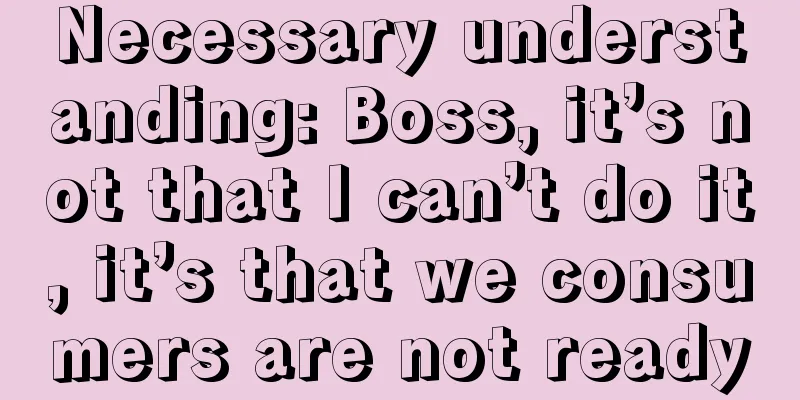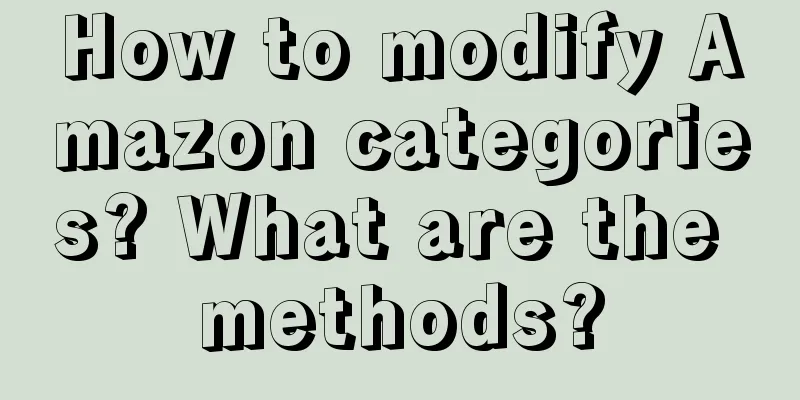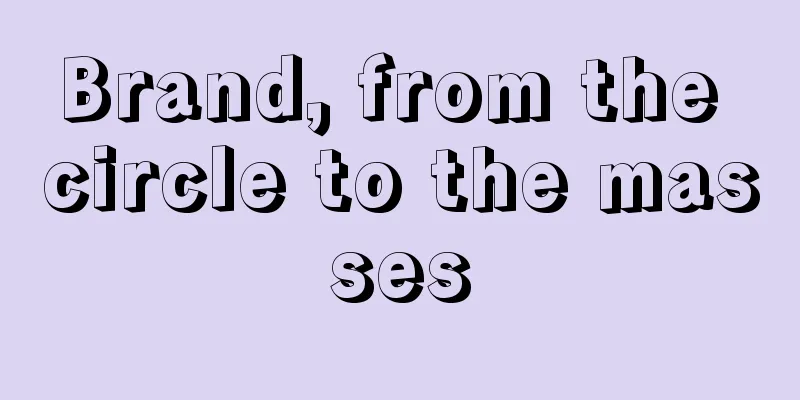Necessary understanding: Boss, it’s not that I can’t do it, it’s that we consumers are not ready

This may be one of the most common soul-searching questions you will receive from your boss at work. To sum it up in one sentence, "Others have succeeded using this method, why doesn't it work for you when you use the same method?" 1. Why can others do it but you can’t?In brand marketing, many startup brands like to spend all day studying the creativity, interactive marketing, and viral communications of successful big brands, but they often don't get good results. It is common to fail by simply copying other people’s practices. In ancient times, there was a special term for this – armchair discussion. There is a passage in the Marching Chapter of Sun Tzu's Art of War:
The general meaning is: As a principle for marching in the mountains, troops should be stationed in high places, and do not attack from above when the enemy occupies the high ground. Sun Wu summarized this from his successful experience of marching and fighting for many years. In a battlefield with high mountains, it is best to station troops in high places, which is not only easy to observe the enemy's situation, but also can charge down by taking advantage of the mountain. Many people in later generations have read this passage in The Art of War, but they have different results in their war practices. There are successful cases, such as Huang Taiji of the Qing Dynasty and Emperor Yongle of the Ming Dynasty, who both won great victories by stationing cavalry on the mountains and attacking the enemy using the terrain. However, there were more failed practices. For example, during the Han Dynasty, Liu Bang stationed his troops on Mount Baideng during the war with the Huns. As a result, his food supply was cut off, and the entire Han Empire was almost destroyed. The most famous example is Ma Su during the Three Kingdoms period. He did not station his troops in the city, but stationed them on the mountains outside the city in accordance with the military tactics. However, he was also defeated and beheaded due to the lack of supplies. There was also the Governor-General Hong Chengchou in the late Ming Dynasty, who stationed his troops on the mountain in the Battle of Songshan and was also defeated, which eventually led to the demise of the Ming Dynasty. At this time, the emperor could actually reprimand the generals: Sun Wu was invincible using this method, why can't you? The same theory had very different results in practice. The fundamental reason was that the failed generals only saw the action of "stationing on the mountain" but did not consider the prerequisite for the success of this action: normal supply of food and grass. The supply of food and grass is the basis of war. If this premise is not guaranteed, no matter how many tactics are said, it is useless. You see, the generals who have been talking about war on paper throughout the ages are very similar to the boss's question at the beginning of the article. This is a very strange phenomenon. We like to imitate other people's successful actions because it is easy, but we rarely delve into the prerequisites for others' success. What is the prerequisite for marketing? Take a look at the following advertisement and feel your first impression. Maybe you will think of words like working overtime late at night, wandering in a foreign land, and going home for the New Year like me. The pictures of overtime also make the workers feel very involved, but it still feels weird. Why? One very important reason is that you don’t know “Lao Hou”, but he connects himself with the family relationship during the Chinese New Year, and you can’t imagine it. If I use the same advertising idea for another big brand, this abrupt feeling of strangeness will be much less. This is the story at the beginning of our article. The marketing ideas that big brands can use may not be applicable to small brands because small brands do not have certain prerequisites. What are the prerequisites for these marketing successes? 2. Necessary cognition and additional cognitionOur brain can divide any concept into two parts: necessary cognition and additional cognition. The emotional output of big brand marketing is actually communicating additional cognition, but the premise for this to succeed is that the big brand has already built the necessary cognition in the consumer's mind. Necessary cognition is the responsibility of the part of the brain that processes memory and is a collection of existing cognitive information. For example, when a consumer sees the three words "Xu Fuji", he or she will instantly have some subconscious associations, such as what it sells (candy), its characteristics (New Year gift-giving scene), where it is often seen (supermarket), etc. This shows that consumers have established the necessary cognition of "Xu Fuji". However, when most consumers see the two words "老侯", their brains have no corresponding memory or cognition, which is not much different from seeing the characters "놔ほ". This is because they have not established the necessary cognition of "老侯". Additional cognition refers to consumers' emotions and social associations beyond necessary cognition, which are usually output by brands in order to get closer to consumers and establish stronger connections. For example, Xu Fuji, on the basis of selling candies, attracts attention through marketing ideas such as "long history", "professional image" and "New Year's flavor", which is to enrich the additional perception of the brand. Additional recognition will make the brand image fuller and easier to remember. It's like if you were talking to an ancient person about cars, how would you describe it? A box that is automatic, consumes gasoline, and a person can sit inside? What is gasoline? What is automatic? It would be difficult for them to understand if you say that a car is a carriage that does not need horses to pull it, then it is easy to understand. Here, "horse-drawn carriage" is the necessary cognition of the ancients, and concepts such as "automatic, gasoline, and automobile" are additional cognition. It can be said that with the necessary cognition as the foundation, additional cognition has a place to attach. An unfamiliar brand is a new concept to consumers. If the necessary cognition is not established, inputting additional cognition will be ineffective. If you look at the marketing of big brands, you will find that they all focus on the necessary cognition in the early stages of development. For example, McDonald's is a source of happiness for children in their childhood. It represents an optimistic spirit of life and a simple and relaxing dining experience, all of which are based on the necessary cognition - "a fast food brand that combines efficiency and quality." The marketing of these brands for additional cognition is often not closely related to the product’s own functions, but is only to enrich the brand connotation and stimulate consumer associations. For example, Safeguard is carrying out activities to protect the health of families across the country, and Apple is promoting the entire supply chain to fulfill social responsibilities. A common mistake made by small brands is to invest huge marketing costs to output value for additional cognition before implanting the necessary cognition. For example, Yili's Chocolatier made an advertisement a few years ago. The style of this advertisement was based on mature brands such as Dove and Meiji. The whole advertisement was about a female idol in a toy fairytale castle, using a toy remote control to control a boy, creating a feeling of love and sweetness. I feel the feeling of love, but this does not answer the fundamental question of consumers: Why should I buy Chocolatier instead of something else? This question is the core of the necessary brand recognition. 3. Why should I buy you instead of others?You may ask: Can't I refer to the practices of big brands when creating advertising ideas? Of course not, but as Sun Tzu's Art of War mentioned at the beginning of this article, the first thing we need to learn is not what to do specifically, but to lay the foundation for victory in the battle. Take McDonald's for example. Now we see that its marketing is basically related to children because its target audience is children and young people in the family. But in fact, it was originally a drive-in restaurant that developed rapidly with the rapid development of the intercity highway network in the United States. At that time, it focused on fast and high-quality cooked food, which was specially provided to drivers. So starting 50 years ago, McDonald's used the slogan "You deserve a break today" for many years to fit the value of fighting for the interests of drivers and workers in the labor dispute at that time. How does McDonald's attract children as customers? Kroc, the founder of McDonald's, was an old acquaintance of Walt Disney. He borrowed a lot of Disney's practices when developing McDonald's, and even used the same group. McDonald's used the people who designed the exterior of Disney to design the exterior of McDonald's Park, and used the people who wrote songs for Disney to make McDonald's advertisements. In McDonald's restaurants, there are bright colors, sports fields specifically for children, toys, small and cute children's meals, and small toys tied to Disney IP. Almost everything is designed to leave a pleasant impression on children. It is conceivable that if a McDonald's located next to the highway suddenly distributed candy on Halloween and invited customers to eat it, it would be useless because drivers would not like it. McDonald's can now use value-added marketing to strongly bind with children, based on the fact that in the past few decades it has refreshed the necessary cognition in all aspects of facilities, products, and services, consolidating the impression that McDonald's is "fast food that brings joy." The reason why so much space is spent on talking about the difference between necessary cognition and additional cognition is that for our brain, before enriching and strengthening a cognition, we need to find a place for this cognition first, and the skills required for the two are different . Imagine if you were an interviewer and the interviewee started his self-introduction by saying "I like traveling, I am good at sports, and I like to check in at various museums and exhibitions." How would you feel? Would you feel that the information is scattered and it is difficult to leave any impression? In contrast, if the interviewer had said "I am a college student, majoring in sociology and minoring in photography" before saying the above, wouldn't your impression of him be much more concrete? You would have associations such as "students studying liberal arts are good at sports and are really versatile." This is because the interviewer has found a storage place in your mind through your identity as a college student and the major you studied, so your interests and hobbies extended from this are easily understood and accepted. The same goes for brand marketing. If consumers don’t know what you do or why they should buy from you, then your spirit and culture will be meaningless and will be easily forgotten because there is no storage location for this information in the brain. If you have necessary cognition and rich additional cognition, it will be easier for you to remember and think of this person. This is complementary. For human memory, necessary cognition mainly includes gender, name, occupation, etc. So for brands, what information must consumers remember? 4. Necessary cognition for new brand marketingNew brand marketing first needs to establish three necessary cognitions, which are:
1. Product categoriesThe first impression of a product often comes from your definition of its category. Take a look at the poster below. What do you think? Does it feel a bit strange? Because you don’t know whether it is a gimbal (which means it may be a device worth around a thousand yuan) or a Bluetooth speaker (which may only cost a few hundred yuan). It is very important for new brands to clearly tell consumers which category they belong to, because the category of a product often means the problem that the product can solve and the consumer’s “psychological account”. Many business cases in the past have told us that category positioning often has a significant impact on the success or failure of a product. When Sony first launched AIBO, a robot dog, it was categorized as a "robot" and received a lukewarm response from the market because its functions were not very impressive for a robot. Later, Sony changed its promotional strategy and positioned it as a "pet", which became a hit because its various bugs made it look like a silly pet that was not completely obedient. This is because with robots, consumers expect complex and precise instructions and feedback, while with pets, it is to satisfy the desire for protection and pleasure. Another example is Swatch watches, which positioned themselves as accessories rather than watches. They adopted many gorgeous and popular elements, invited a large number of artists and designers to design their watches, and provided different styles according to the changes in seasons and trends, thus successfully breaking through the market of many high-end Swiss watches. Luckin Coffee was on the verge of delisting due to its coffee business, but it came back to life by making milk coffee. This is because the coffee category focuses on craftsmanship and requires high-cost training for baristas, while milk coffee is more like milk tea and can expand rapidly through standard processes and low-cost franchising. Looking back at the examples above, whether it is a mechanical pet, a jewelry watch, or milk coffee, the secret to the success of a product or brand is to become the first in a certain category. If there are already competitors in the category, then create a new category that can be the first. Once you decide on the product category, you need to communicate it clearly to build the necessary awareness among your consumers. 2. Competitive AdvantageJust like choosing a partner, after confirming that the other person is of the opposite sex, the next thing to consider is why you choose him/her instead of someone else. For a new product, after telling consumers what purpose it can help them achieve, the next step is to explain why you can do it better than others. For example, if you make a new brand of rice cookers that can help consumers cook delicious rice, the reason for buying your rice cooker instead of Midea is that your rice cooker can save 50% of electricity when cooking the same rice. The reason should be a keyword that people can remember immediately, and it should be closely related to the task that consumers need to complete, such as energy saving. However, portability is not an important feature for household rice cookers (it is another case for those that are mainly used in outdoor scenes). A category often has many characteristics, such as umbrellas. Traditional umbrella brands compete on the dimensions of portability, appearance, and durability, but Jiaoxia has identified the factor of sun protection and has broken through in the umbrella market in one fell swoop. Focusing on a dimension in a category that consumers pay attention to but is ignored by competitors is a common tactic in the history of brand marketing and it works every time. The competition between Uni-President and Master Kong, two instant noodle brands, is very representative. Both of them are from Taiwan, China. Master Kong entered the mainland market earlier than Uni-President, but it was not until Master Kong's market share reached 65% that Uni-President entered the mainland market belatedly. At the beginning, Uni-President wanted to make a comeback in brand awareness (Uni-President started out as an instant noodle manufacturer, while Master Kong made cooking oil, and instant noodles were just a marginal product), and invested a lot in advertising to promote its brand, but Master Kong’s first-mover advantage in brand awareness was already difficult to shake. Later, Uni-President changed its strategy and launched a new product called "Uni-President 100", which increased the weight of the noodles in the instant noodles from 75 grams to 100 grams. Later, it launched "One Bucket", increasing the number of noodles from one to two. The purpose of doing so is to make consumers shift their focus from looking at the brand to the weight of the instant noodles when choosing instant noodles (after all, the weight of instant noodles has a lot to do with filling the stomach). Uni-President's market share quickly rose to around 30% and established a firm foothold. A good reason to buy corresponds to a key feature that perceptibly affects the quality and efficiency with which the consumer performs his task. So if the key features of your product are not blank, but there are already other brands, is it still possible to counterattack? At this time, you need the third necessary cognition - trust endorsement. 3. Trust endorsementTrust endorsement means giving consumers a reason to believe what you say. For example, if you say your instant noodles are more filling, why should consumers believe you? Because your noodles are heavier and bigger, this is a very strong trust endorsement. There are two main forms of trust endorsement – central path and peripheral path. The central path is easy to understand, which is to directly talk about the objective nature of the brand:
The peripheral path is to endorse the brand through external, indirect information:
Another method that can quickly attract attention and trigger dissemination in the current era of fragmented information is "extreme scenario". Taking the umbrella category above as an example, Jiaoxia wants to occupy consumers' cognition with its sun protection function, but parasols are not a newly discovered demand. There are already many brands on the market that can block ultraviolet rays. Jiaoxia gave a convincing reason to consumers - "space suit material". The material can block various rays of the universe, so it is believed that blocking ultraviolet rays is no problem. Another example is the Dutch brand Vollebak, which I like very much recently. They are an outdoor brand that takes technology to the extreme and makes clothes that can adapt to the "doomsday environment". For example, they have a jacket that claims to be able to "resist the apocalypse". It uses PBI, a highly flame-retardant material developed by NASA for the Apollo program, which can resist volcanic lava, extreme climates, chemical corrosion, and even zombie attacks. Since it can withstand the apocalypse, it is certainly no problem for daily outdoor activities. This is a good endorsement of trust. V. ConclusionWhen we imitate big brands to carry out brand marketing activities, the reason for the poor results is often not due to poor execution, but due to poor construction in the minds of consumers. This is like following Sun Tzu's Art of War to fight a war. In the end, the reason for losing the war is not because the general had problems with his command, but because he ignored other more important prerequisites for victory. When we do marketing, if the brand does not root the necessary cognition in the minds of consumers, no matter how much additional cognition is added, it will be useless. Next time your boss asks you why your marketing campaign isn’t working, you can tell him that it’s because consumers aren’t ready for your brand. Author: Mr. He, public account: "Yuanwai He" (ID: Yuanwai-HE) |
<<: The “stolen” Guka business
>>: What is your keyword for 2022?
Recommend
How can Amazon avoid association? Will Amazon be associated if it uses a mobile network card?
The act of associating Amazon accounts violates th...
Can Amazon emails be withdrawn? How to do Amazon?
Amazon's e-commerce market is huge, and now mo...
Crazy Thursday, can you still afford it?
It's Thursday again. Has anyone sent you a mes...
This article tells you what is hidden behind “customer needs”?
How to find inspiration from products and discover...
eBay Canada adjusts fees for selling sneakers
eBay Canada recently announced that eBay is adjust...
What does overseas marketing do? What about doing overseas sales?
It is not easy to do e-commerce. If there is one t...
What is the settlement unit price of Shopee SIP products? How to adjust product prices using the SIP price adjustment ratio?
SHOPEE has released a new SIP price adjustment rat...
How can I check the traffic of Wish? How can I increase the traffic of Wish?
In the ocean of e-commerce, Wish platform has beco...
Chinese Partners
On July 25, Dongfang Zhenxuan announced that Dong ...
A method to quickly identify the intention of interview questions
This article reveals the two core considerations o...
Nongfu Spring's "Ice Cup" is a big hit, boosting its unpopular products and revealing new offline marketing ideas
This article explores how Nongfu Spring drives bra...
TikTok Shop, a copycat for Southeast Asia
This article introduces the rapid development of T...
How to cancel Amazon vacation mode? Steps
During the Spring Festival, many Amazon merchants ...
Data Operations | The first step to using data—finding data
This article is an in-depth discussion on data ope...
Damn! I'm surrounded by the wool party [Part 2]
"The wool party" refers to those who spe...









